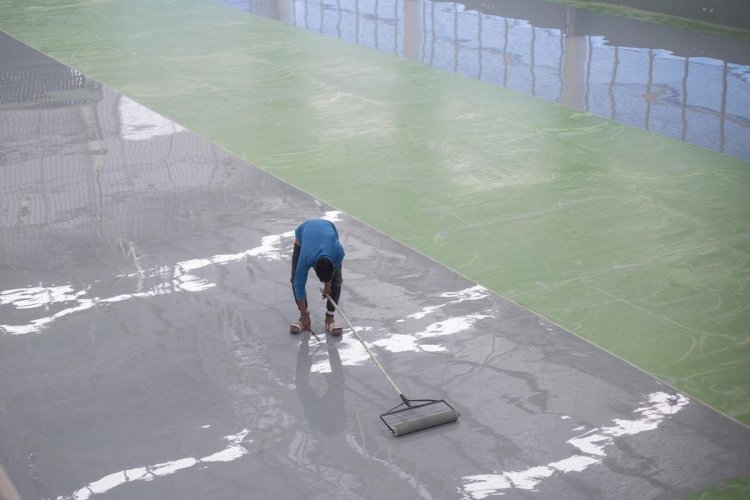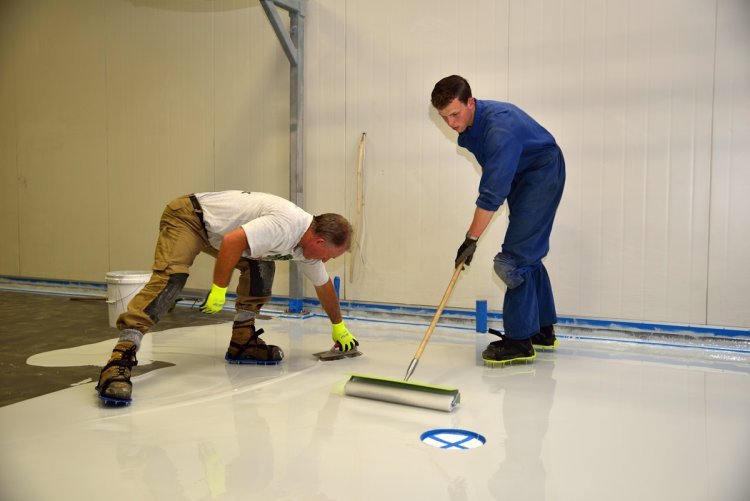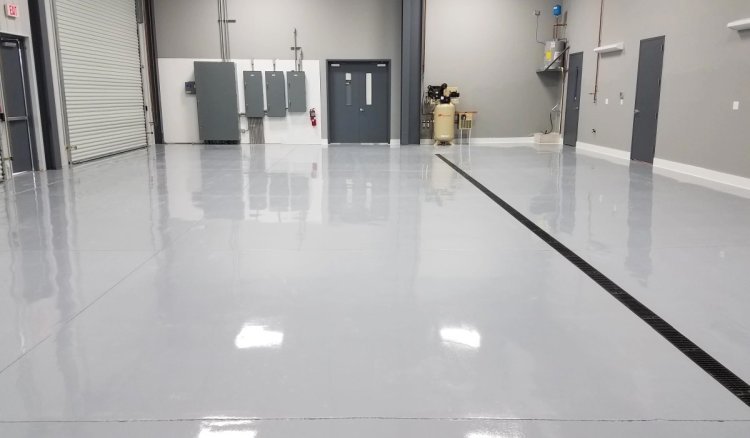Paint Vs. Coating Which Is Better For Your Garage Floor?
Paint Vs. Coating Which Is Better For Your Garage Floor? When thinking about your garage floors, it's crucial to consider how to keep them safe and looking good.

Choosing Between Paint And Coating For Your Garage Floor
When thinking about your garage floors, it's crucial to consider how to keep them safe and looking good. There are two primary choices for this: paint and coating. Both options provide a layer of protection against stains and damage. Paint adds color but may not be as durable as a coating. But a coating offers long-lasting defense against wear and tear. If you're looking for a reliable solution, consulting with a coating manufacturer can help you find the best fit for your needs. Making the right choice ensures your garage floors stay protected for years to come.
Exploring Garage Floor Coatings:
Garage floor coatings are protective layers. They are applied to garage floors to improve durability, appearance, and cleanliness. They provide a barrier against stains, chemicals, oil, moisture, and abrasion. This makes the garage floor easier to clean and maintain. Two popular types of garage floor coatings are epoxy and polyurethane-based coatings.
Epoxy Coatings:
Epoxy coatings are composed of epoxy resins and a hardener. When mixed, they create a strong, durable, and chemically resistant surface.
Polyurethane Coatings:
Polyurethane-based garage floor coatings offer similar protection to epoxy coatings. But, they differ in how they are applied and their traits.
Application Process For Garage Floor Coatings
The process is crucial for applying garage floor coatings. They can be epoxy- or polyurethane-based. It's key to getting great and long-lasting results.
Surface Preparation:
Clean the Surface:
Remove all dirt, dust, oil, grease, and other contaminants from the garage floor surface. Use a degreaser or concrete cleaner, along with scrub brushes or pressure washers, to thoroughly clean the floor. Rinse the surface with clean water and allow it to dry completely.
Repair Cracks and Imperfections:
Fill any cracks, divots, or holes in the concrete using an appropriate concrete patching compound. Smooth out the patched areas and allow them to cure fully according to the coating manufacturer's instructions.
Etch the Surface (for Epoxy Coatings):
Etching the concrete surface helps open up the pores of the concrete, allowing for better adhesion of the epoxy coating. Use an acid etching solution or mechanical grinder to etch the surface. Rinse the floor thoroughly with water and allow it to dry completely before proceeding.
Application of Coating:
Mix the Coating Components:
Follow the manufacturer's instructions to mix the epoxy or polyurethane coating components. Ensure thorough mixing to activate the chemicals properly.
Apply Primer Coat (for Epoxy Coatings):
If using an epoxy coating, apply a primer coat to the prepared surface. Use a roller or brush to spread the primer evenly across the floor. Allow the primer to cure according to the manufacturer's instructions.
Apply Base Coat:
Once the primer coat has cured (for epoxy coatings), apply the base coat of epoxy or polyurethane to the floor. Use a roller or squeegee to spread the coating evenly, working in small sections to ensure thorough coverage.

Optional Decorative Chips (for Epoxy Coatings):
If desired, broadcast decorative chips or flakes onto the wet base coat to add texture and visual appeal. Allow the base coat to cure partially before applying the chips.
Apply Topcoat:
After the base coat (and decorative chips, if used) have cured sufficiently, apply the topcoat of epoxy or polyurethane. Again, use a roller or squeegee to ensure even coverage. This topcoat provides additional protection and durability for the floor.
Curing and Drying:
Allow Sufficient Curing Time:
After applying the coatings, allow them to cure according to the manufacturer's recommendations. This means keeping foot and vehicle traffic off the floor for a while. This gives the coatings time to fully harden and bond to the concrete.
Provide Adequate Ventilation:
Ensure proper ventilation during the curing process to help dissipate any fumes from the coatings. Open windows and use fans to improve airflow in the garage.
The Superior Durability And Resistance Offered By Coatings
Coatings for garage floors, like epoxy and polyurethane, are much more durable and resistant than bare concrete. These coatings provide a barrier. It protects and improves garage floors. They offer several key benefits:
Chemical Resistance:
- Coatings for garage floors are made to withstand exposure to many chemicals. These include those commonly found in car fluids, household cleaners, and other substances.
- Epoxy and polyurethane coatings create a non-porous surface. This stops chemicals from penetrating the concrete below. It protects the underlying concrete from damage.
- This resistance to chemicals prevents staining, etching, and wearing down the garage floor. It keeps the floor in good condition over time. This is true even in places where exposure to harsh chemicals is common.
Oil Resistance:
- One of the primary concerns in garage environments is the potential for oil spills and leaks from vehicles and machinery. Garage floor coatings offer excellent resistance to oil penetration and staining.
- Epoxy and polyurethane coatings form a seamless and watertight surface. This surface stops oil from seeping into the concrete. It makes the concrete easier to clean and maintain.
- Spilled oil can be quickly wiped up without leaving behind unsightly stains or causing long-term damage to the floor. This helps preserve the appearance and integrity of the garage floor over the long term.
Abrasion Resistance:
- People walk and drive on garage floors. They also get scraped by tools, equipment, and other objects. Coatings provide a durable and abrasion-resistant surface that can withstand these stresses.
- Epoxy and polyurethane coatings create a hard surface. It resists wear and tear, stopping scratches, scuffs, and other damage from friction and impact.
- This resistance helps keep the garage floor looking good. It stops it from wearing or getting pits. It also contributes to the longevity of the coating, ensuring that it remains effective for years to come.
Downsides To Consider When Choosing Floor Coatings
Garage floor coatings offer many benefits. But, there are some downsides to consider:
1. Longer Drying Times:
- Garage floor coatings typically need longer drying and curing times compared to simple paint. This can prolong the time it takes to complete the project and may require the garage to be out of commission for a longer period.
2. Higher Cost:
- Garage floor coatings, especially epoxy and polyurethane options, tend to be more expensive than basic paint. The cost of materials and labor for proper surface prep and painting can add up. This makes it a bigger investment than painting the floor.
But, the durability and long-term protection of coatings often outweigh these downsides. They are for those seeking to effectively enhance and protect their garage floors.
Exploring Garage Floor Paint:
Garage floor paint is a type of coating applied to garage floors to enhance appearance and protect the surface from wear, stains, and damage. It is usually a blend of resins, pigments, and additives. It is meant to provide adhesion, durability, and resistance to chemicals and abrasion. Garage floor paint comes in various types, such as latex, acrylic, and epoxy-based paints. Each type has different levels of durability and performance.
Application Process, Including Preparation And Tools Required.
The process of applying garage floor paint has many steps. It includes preparing the surface well and using the right tools. Here's a breakdown of the process:
Surface Preparation:
Clean the Surface:
- Remove all dirt, dust, oil, grease, and other contaminants from the garage floor surface. Use a degreaser or concrete cleaner, along with scrub brushes or a pressure washer, to thoroughly clean the floor. Rinse the surface with clean water and allow it to dry completely.
Repair Cracks and Imperfections:
- Fill any cracks, divots, or holes in the concrete using an appropriate concrete coating compound. Smooth out the patched areas and allow them to cure fully according to the manufacturer's instructions.
Etch the Surface (optional):
- Some garage floor paints may require etching the surface to improve adhesion. Follow the manufacturer's instructions to etch the surface. You can use an acid etching solution or a mechanical grinder. Rinse the floor thoroughly with water and allow it to dry completely before proceeding.
Application of Paint:
Choose the Right Paint:
- Select a garage floor paint suitable for your needs, considering factors such as durability, color, and finish.
Prepare the Paint:
- Stir the paint thoroughly to ensure proper mixing of pigments and resins.
Apply Primer (if required):
- Some garage floor paints may require a primer coat for improved adhesion and durability. Follow the manufacturer's instructions to apply the primer evenly across the floor using a roller or brush. Allow the primer to dry completely before applying the paint.
Apply Paint:
- Pour the garage floor paint into a paint tray. Use a roller with a long handle to apply the paint evenly across the floor, working in small sections. Use a brush to cut in around the edges and corners.
Optional Decorative Effects:
- Some garage floor paints allow for the addition of decorative chips or flakes for texture and visual appeal. Broadcast the chips or flakes onto the wet paint and use a roller to press them into the surface if desired.
Curing and Drying:
Allow Sufficient Drying Time:
- After applying the paint, let it dry fully. Follow the maker's recommendations. Avoid walking or driving on the freshly painted surface until it has cured fully.
Provide Ventilation:
- Ensure proper ventilation during the drying process to help dissipate any fumes from the paint. Open windows and use fans to improve airflow in the garage.
Tools Required:
- Pressure washers or scrub brushes
- Concrete cleaner or degreaser
- Concrete patching compound
- Acid etching solution or mechanical grinder (if etching is required)
- Paint roller with extension handle
- Paintbrush
- Paint tray
- Optional: decorative chips or flakes
Benefits Of Garage Floor Paint
Garage floor paint offers:
Customization:
Choose from various colors and finishes to match your style.
Improved Appearance:
Covers imperfections and enhances the overall look of the floor.

Protection and Durability:
Resists stains, chemicals, and abrasion, extending the floor's lifespan.
Easy Application:
DIY-friendly with simple tools and techniques.
Cost-Effective:
Provides benefits similar to other coatings at a lower price point.
Garage Floor Paint limitations
Garage floor paint has limitations:
1. Wear Susceptibility:
- Prone to chipping and peeling, especially in high-traffic areas.
2. Shorter Lifespan:
- May require more frequent reapplication compared to coatings for long-term protection.
But, garage floor paint has these drawbacks. But, it remains a popular and cheap way to improve the look and function of garage floors.
Considerations for Decision-Making:
When deciding whether to use paint or coatings for garage floors, several factors matter. They include the type of garage (home or commercial). Also, the level of usage (light or heavy), budget limits, and maintenance needs. And the desired longevity. Here's a comparison of paint and coatings in various scenarios:
Residential vs. Commercial Garages:
Residential Garages:
Garage floor paint is good for light use. It can be cheap and look good. It provides customization options and better looks. It also offers basic protection against stains and wear.
Commercial Garages:
In busy places, durability and longevity are key. So, coatings like epoxy or polyurethane are preferred. The coatings resist chemicals, abrasion, and heavy loads well. This makes them ideal for commercial or industrial settings.
Light vs. Heavy Use:
Light Use:
Residential garages have little foot and vehicle traffic. Garage floor paint can protect them and make them look better. It does this at a lower cost.
Heavy Use:
Garages get heavy use. This is especially true of commercial workshops and automotive repair facilities. Coatings offer them better durability and resistance to wear, chemicals, and abrasion. Epoxy or polyurethane coatings are recommended for these applications to ensure long-term performance.
Factors to consider when choosing between paint and coatings include:
1. Budget:
Garage floor paint is generally more affordable upfront compared to coatings. However, coatings offer better long-term value. This is because they are more durable and last longer. They may also reduce the need for frequent reapplications.
2. Maintenance Requirements:
Painted garage floors may need more frequent maintenance. They also need more frequent recoating to maintain their appearance and protection. Coatings typically require less maintenance and offer superior resistance to stains and wear.
3. Desired Longevity:
Coatings, such as epoxy or polyurethane, last longer than garage floor paint. They also provide more protection and durability. They resist chemicals, abrasion, and heavy loads. This makes them better for applications where longevity is key.
What's Your Reaction?











![Wireless Connectivity Software Market Size, Share | Statistics [2032]](https://handyclassified.com/uploads/images/202404/image_100x75_661f3be896033.jpg)




